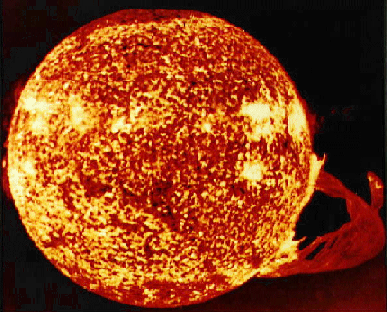Fusion
Process of the Sun
Short
Summary
Original
Version for Printing
|
Mankind assumes the fusion of Hydrogen to
Helium elements is the primary process by which heat and light is produced within a
most stellar objects. An examination of a spectrographs of the emitted light
from our Sun and similar other stellar objects reveals a composition of 74% H and 24% He and 2% trace elements. Although
reaction occurring inside the core of a stellar object is process of
compression and process of transfer of
subatomic particles streams between atomic structures of matter within
close proximity where the percentage of light elements, like hydrogen
and helium to heavy elements, which dampens or controls the fusion reaction rate.
When a localized
big bang occurs in a galactic region, like ours,
the Milky Way, it is the
heavy elements that coalesce first. Once established it is the gravitational attraction to
this mass that gathers the lighter elements. As the assimilation of matter
proceeds, the solar object grows until the available matter with in local
gravitational area is a balance of matter added to that which is lost to outside
forces. |
|
 |
To get a
clearer picture of the dampening process of heavy elements, lets look at the
present technology of fission reactors on Earth. The fission process releases
energy when two purified masses of uranium or man made elements outside of the
norm combined produce a reaction that goes critical from an increasing set of cascading collisions
due to released subatomic particles, resulting in an
explosion when isolated the separate masses would be relatively stable. In the
absence of all controls a run away reaction would
affect vast areas with destruction. An example would be a nuclear power plant,
where the placement of these control rods with absorb the subatomic particle
flow that would accelerate a reaction, thus preventing critical mass, a
dampener just like the heavy elements in a stellar mass. When under control, where the rate of reaction is
reduced to a state where the reaction produces a steady source of heat and energy.
For
the fusion process to engage, both compression and heat are needed in large
quantities. Inside our Sun this is normal, due to intense gravitational
subatomic particles flow resulting in compression and restrictive molecular
movement in and near the core. The compression insures a shared space on the
atomic level and heat extends the range of the electron subatomic particle
stream initializing sharing. But when mankind applies a pulse of intense heat
and compression to light element fuel components, it explodes. No control
factors were ever pondered.
A stellar mass without heavy elements, is
the equivalent to the absence of controls, thus the reaction would supernova,
emulating on an infinitesimal scale, mankindís experience with the hydrogen bomb. Spectroscopic analysis,
which separates light emanating from the Sun into a pattern of colors, as
scientists evaluate the proportional breakdown of elements that are
present in
burning and ejected at the surface of solar masses. Although, it fails to show a signature
trace of the heavy elements that has accumulated in and around the core.
The
intense
gravitational field of the Sun near the core impedes and bends the flow of light particles
from the heavy elements.
That in conjunction with dispersion light particles as they proceed away from this
same source, the result dilution due to distance
traveled from the heart of the Sun. The elements of hydrogen and helium burning
near the surface of the Sun does not have to contend with light absorption,
gravitational bending, and dispersion of the particle field. Allowing the
lighter elements floating near the surface of the Sun, to overwhelm the true
proportion of the elements burning within the Sun. The fusion process is only a
subordinate part of the process producing heat and light in the Sun. The build
up of a by-product of fusion, molecular motion, provides the primary source of
energy in the Sun. The fusion process, which is maintained by very small amount
of hydrogen mass. When atoms are forced to together there is a sharing of
electron subatomic particle streams and there is the build up or take away that is the foundation. The
electron related subatomic particles are added by compression, to the flow
through the nucleus. This concept is covered in the
atomic structure. As the nucleus
loses charged subatomic particles the atomic structure takes an
antimatter charge because of the imbalance of the added electron stream
subatomic particles related to the proton and neutron are attracted until
stabilization. It is the process and its added layers of producing the upper
levels of elements that is the basis for the fusion process. The energy is released
as a by product, and registers to mankind as heat and light. The
fusion process does behave in a similar fashion as the crude recreation produced
by mankind's nuclear weapons, if so then radiation from incomplete reactions would
kill all life on Earth. Many people assume the atmosphere protects the Earth
from radiation. Therefore, ponder this question, what would happen if a
continuous supply of hydrogen bombs were exploded in space above Earth?
Unassuming answer, all life below would soon cease to exist.
Question: Does
mankind's quest for a fusion reactor hold promise?
The current path of
this world's fusion research will lead to a dead end, but if mankind
amplified gravitational subatomic particle flow
and used this force to initiate and maintain the reaction, then heavy elements
could be used to control the reaction and there would be a viable source of
energy, but the are more efficient ways
soon to be introduced.
All Rights Reserved: © Copyright 2000, 2009
Related Articles
The
12th Planet's Core
Antimatter
